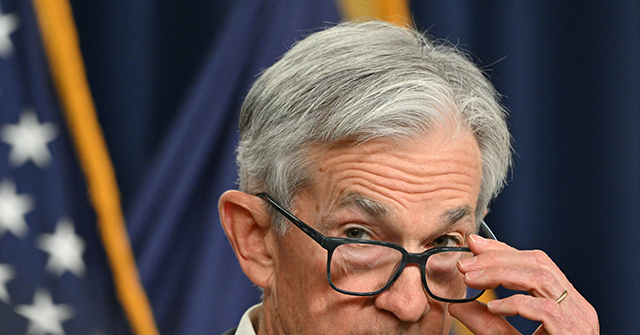The Economy Throws the Fed a Curveball
When the Federal Reserve officials last met in mid-March to decide on interest rates, they signaled hopes that the path of the economy would become clearer over time—giving them a solid perch from which to shape monetary policy. The economy had other plans.
In the seven weeks since that meeting, every key indicator has thrown a curveball. Growth is down, inflation is down, jobs are up, imports are up, and markets are wobbling. Stocks were down a lot in April until they weren’t anymore and ended the month flat. The Fed isn’t any closer to clarity, and the best bet for Wednesday’s meeting is more of the same: strategic hesitation.
Start with growth. First-quarter GDP fell at a 0.3 percent annualized rate, the first contraction since 2022. But that headline hides a crucial detail: the decline was driven not by weak consumer or business demand, but by a surge in imports, which subtract from GDP accounting. In March alone, goods imports jumped 4.4 percent, led by a 71 percent spike in pharmaceutical shipments, as businesses raced to stockpile ahead of Trump’s anticipated tariffs. That front-loading pulled demand forward—into a quarter the Bureau of Economic Analysis had to report as a contraction.
Consumer spending, meanwhile, remains solid. Real personal consumption expenditures rose 1.8 percent in Q1, with durable goods climbing 4.6 percent. Business investment in equipment rose too, even as inventories were drawn down. None of this signals imminent recession.
Inflation? Also mixed. The Fed’s preferred gauge, core PCE, rose 0.3 percent in March, a deceleration from 0.5 percent in January and even with the 0.3 percent recorded in February. On a year-over-year basis, inflation has edged up to 2.8 percent, but March’s monthly reading was essentially flat for headline PCE—hinting at real cooling beneath the surface.
Jobs tell a third story. After disappointing numbers in January (111,000) and February (102,000), March saw a sharp rebound to 185,000. April added 177,000 jobs, handily beating forecasts. The unemployment rate ticked up slightly to 4.2 percent from 4.0 percent at the start of the year, but that reflects rising labor force participation—a good sign. Wage growth, meanwhile, has moderated but remained above the inflation waterline.
Markets, however, are unsettled. After a strong start to the year, equities have been volatile in response to the Trump administration’s ever-changing tariff policies. The S&P 500 fell 5.7 percent in March and was down by even more than that in the darkest days of April. But it rebounded to come in more or less flat for the month. Year-to-date, the S&P is down 4.25 percent; but compared with one year ago, it is up 8.75 percent, a better than average 12 months. Treasury yields have been volatile, with the 10-year approaching five percent back in January and falling just below four percent in mid-April. On Tuesday, 10-year Treasury yields were trading around 4.34 percent.
Trump Pressures ‘Mr. Too Late’
Trump has applied fresh pressure on the Fed, publicly calling for rate cuts and mocking Chair Jerome Powell as “Mr. Too Late.” But the central bank isn’t likely to move this week. The Fed doesn’t cut based on White House commentary or on market whiplash. It cuts when the data tells a clear story.
That’s the problem. There is no clear story.
If you told Powell two months ago that GDP would be negative, inflation would be flat, Treasury yields would be just about where they were, and job gains would top 150,000, he’d probably think you were listing numbers from different economies. And yet, all four are true.
The Fed’s policy stance now resembles a submarine’s periscope—staying low, scanning for signs of danger, unwilling to surface until the waters calm. They’re watching for inflation expectations to stay anchored, the labor market to hold steady, and tariffs to either settle or spike prices definitively. None of that has happened yet.
So, don’t expect fireworks this week. The Fed is stuck between crosscurrents: too strong to ease, too shaky to hike. The best they can do is what they’ve been doing—waiting for the fog to lift. It hasn’t yet.
Read the full article here


